#Model L
Text

don't ask me why i drew this
#kirby#kirby fanart#bandana waddle dee#bandee#crossover#megaman zx#model l#i've never even played zx
36 notes
·
View notes
Text

I know it’s been at least a year and a half since this was requested, but I finally got it done!
In my main Fairy Tail ZX AU, Wendy is paired with Model H (because they’re both wind elemental). @ryuryuhope asked that I draw her paired with the other mainline Biometals.
I gave the Model O form her pink hair from when she’s in Dragon Force mode. I thought it was fitting.
#megaman zx#au#fairy tail#wendy marvell#crossover#model x#model Z#model l#model f#model p#model o#dragon force#yes I take requests (within reason)
9 notes
·
View notes
Text
Light the Future

When the sky rent during Orobouros' explosion, the Biometals were thrown into a world where everything is connected to the Internet.
Connections are made. Made between NetNavi and NetOp, between the past and present, and between a Biometal and its Chosen Ones.
(Chapter 1 has been posted to AO3. The link is right here!)
#lynx's art#rockman.exe#megaman#art#lan hikari#crossover#Megaman ZX#Model X#Model Z#Model H#Model L#Model F#Model P#Fanfic
5 notes
·
View notes
Text
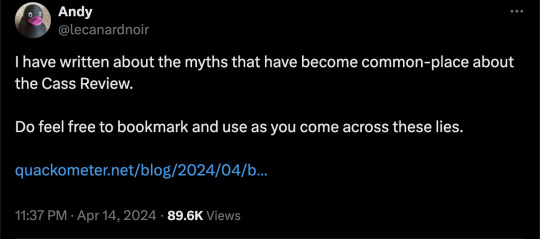
By: Andy L.
Published: Apr 14, 2024
It has now been just little under a week since the publication of the long anticipated NHS independent review of gender identity services for children and young people, the Cass Review.
The review recommends sweeping changes to child services in the NHS, not least the abandonment of what is known as the “affirmation model” and the associated use of puberty blockers and, later, cross-sex hormones. The evidence base could not support the use of such drastic treatments, and this approach was failing to address the complexities of health problems in such children.
Many trans advocacy groups appear to be cautiously welcoming these recommendations. However, there are many who are not and have quickly tried to condemn the review. Within almost hours, “press releases“, tweets and commentaries tried to rubbish the report and included statements that were simply not true. An angry letter from many “academics”, including Andrew Wakefield, has been published. These myths have been subsequently spreading like wildfire.
Here I wish to tackle some of those myths and misrepresentations.
-
Myth 1: 98% of all studies in this area were ignored
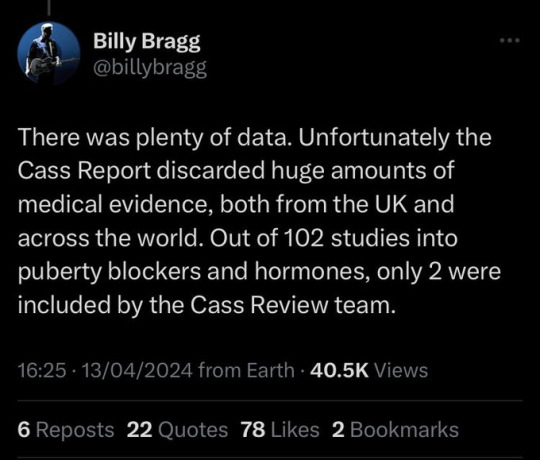
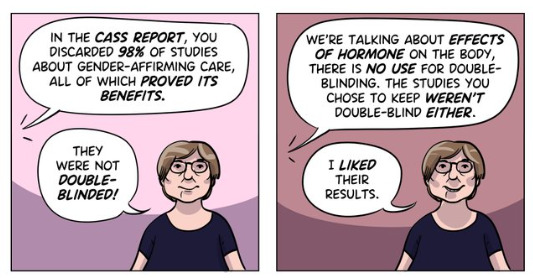
Fact
A comprehensive search was performed for all studies addressing the clinical questions under investigation, and over 100 were discovered. All these studies were evaluated for their quality and risk of bias. Only 2% of the studies met the criteria for the highest quality rating, but all high and medium quality (50%+) studies were further analysed to synthesise overall conclusions.
Explanation
The Cass Review aimed to base its recommendations on the comprehensive body of evidence available. While individual studies may demonstrate positive outcomes for the use of puberty blockers and cross-sex hormones in children, the quality of these studies may vary. Therefore, the review sought to assess not only the findings of each study but also the reliability of those findings.
Studies exhibit variability in quality. Quality impacts the reliability of any conclusions that can be drawn. Some may have small sample sizes, while others may involve cohorts that differ from the target patient population. For instance, if a study primarily involves men in their 30s, their experiences may differ significantly from those of teenage girls, who constitute the a primary patient group of interest. Numerous factors can contribute to poor study quality.
Bias is also a big factor. Many people view claims of a biased study as meaning the researchers had ideological or predetermined goals and so might misrepresent their work. That may be true. But that is not what bias means when we evaluate medical trials.
In this case we are interested in statistical bias. This is where the numbers can mislead us in some way. For example, if your study started with lots of patients but many dropped out then statistical bias may creep in as your drop-outs might be the ones with the worst experiences. Your study patients are not on average like all the possible patients.
If then we want to look at a lot papers to find out if a treatment works, we want to be sure that we pay much more attention to those papers that look like they may have less risk of bias or quality issues. The poor quality papers may have positive results that are due to poor study design or execution and not because the treatment works.
The Cass Review team commissioned researchers at York University to search for all relevant papers on childhood use of puberty blockers and cross-sex hormones for treating “gender dysphoria”. The researchers then graded each paper by established methods to determine quality, and then disregarded all low quality papers to help ensure they did not mislead.
The Review states,
The systematic review on interventions to suppress puberty (Taylor et al: Puberty suppression) provides an update to the NICE review (2020a). It identified 50 studies looking at different aspects of gender-related, psychosocial, physiological and cognitive outcomes of puberty suppression. Quality was assessed on a standardised scale. There was one high quality study, 25 moderate quality studies and 24 low quality studies. The low quality studies were excluded from the synthesis of results.
As can be seen, the conclusions that were based on the synthesis of studies only rejected 24 out of 50 studies – less than half. The myth has arisen that the synthesis only included the one high quality study. That is simply untrue.
There were two such literature reviews: the other was for cross-sex hormones. This study found 19 out of 53 studies were low quality and so were not used in synthesis. Only one study was classed as high quality – the rest medium quality and so were used in the analysis.
12 cohort, 9 cross-sectional and 32 pre–post studies were included (n=53). One cohort study was high-quality. Other studies were moderate (n=33) and low-quality (n=19). Synthesis of high and moderate-quality studies showed consistent evidence demonstrating induction of puberty, although with varying feminising/masculinising effects. There was limited evidence regarding gender dysphoria, body satisfaction, psychosocial and cognitive outcomes, and fertility.
Again, it is myth that 98% of studies were discarded. The truth is that over a hundred studies were read and appraised. About half of them were graded to be of too poor quality to reliably include in a synthesis of all the evidence. if you include low quality evidence, your over-all conclusions can be at risk from results that are very unreliable. As they say – GIGO – Garbage In Garbage Out.
Nonetheless, despite analysing the higher quality studies, there was no clear evidence that emerged that puberty blockers and cross-sex hormones were safe and effective. The BMJ editorial summed this up perfectly,
One emerging criticism of the Cass review is that it set the methodological bar too high for research to be included in its analysis and discarded too many studies on the basis of quality. In fact, the reality is different: studies in gender medicine fall woefully short in terms of methodological rigour; the methodological bar for gender medicine studies was set too low, generating research findings that are therefore hard to interpret. The methodological quality of research matters because a drug efficacy study in humans with an inappropriate or no control group is a potential breach of research ethics. Offering treatments without an adequate understanding of benefits and harms is unethical. All of this matters even more when the treatments are not trivial; puberty blockers and hormone therapies are major, life altering interventions. Yet this inconclusive and unacceptable evidence base was used to inform influential clinical guidelines, such as those of the World Professional Association for Transgender Health (WPATH), which themselves were cascaded into the development of subsequent guidelines internationally.
-
Myth 2: Cass recommended no Trans Healthcare for Under 25s
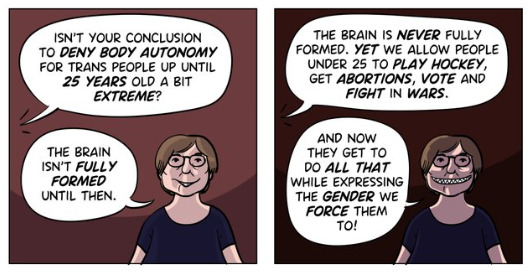
Fact
The Cass Review does not contain any recommendation or suggestion advocating for the withholding of transgender healthcare until the age of 25, nor does it propose a prohibition on individuals transitioning.
Explanation
This myth appears to be a misreading of one of the recommendations.
The Cass Review expressed concerns regarding the necessity for children to transition to adult service provision at the age of 18, a critical phase in their development and potential treatment. Children were deemed particularly vulnerable during this period, facing potential discontinuity of care as they transitioned to other clinics and care providers. Furthermore, the transition made follow-up of patients more challenging.
Cass then says,
Taking account of all the above issues, a follow-through service continuing up to age 25 would remove the need for transition at this vulnerable time and benefit both this younger population and the adult population. This will have the added benefit in the longer-term of also increasing the capacity of adult provision across the country as more gender services are established.
Cass want to set up continuity of service provision by ensure they remain within the same clinical setting and with the same care providers until they are 25. This says nothing about withdrawing any form of treatment that may be appropriate in the adult care pathway. Cass is explicit in saying her report is making no recommendations as to what that care should look like for over 18s.
It looks the myth has arisen from a bizarre misreading of the phrase “remove the need for transition”. Activists appear to think this means that there should be no “gender transition” whereas it is obvious this is referring to “care transition”.
-
Myth 3: Cass is demanding only Double Blind Randomised Controlled Trials be used as evidence in “Trans Healthcare”

Fact
While it is acknowledged that conducting double-blind randomized controlled trials (DBRCT) for puberty blockers in children would present significant ethical and practical challenges, the Cass Review does not advocate solely for the use of DBRCT trials in making treatment recommendations, nor does it mandate that future trials adhere strictly to such protocols. Rather, the review extensively discusses the necessity for appropriate trial designs that are both ethical and practical, emphasizing the importance of maintaining high methodological quality.
Explanation
Cass goes into great detail explaining the nature of clinical evidence and how that can vary in quality depending on the trial design and how it is implemented and analysed. She sets out why Double Blind Randomised Controlled Trials are the ‘gold standard’ as they minimise the risks of confounding factors misleading you and helping to understand cause and effect, for example. (See Explanatory Box 1 in the Report).
Doctors rely on evidence to guide treatment decisions, which can be discussed with patients to facilitate informed choices considering the known benefits and risks of proposed treatments.
Evidence can range from a doctor’s personal experience to more formal sources. For instance, a doctor may draw on their own extensive experience treating patients, known as ‘Expert Opinion.’ While valuable, this method isn’t foolproof, as historical inaccuracies in medical beliefs have shown.
Consulting other doctors’ experiences, especially if documented in published case reports, can offer additional insight. However, these reports have limitations, such as their inability to establish causality between treatment and outcome. For example, if a patient with a bad back improves after swimming, it’s uncertain whether swimming directly caused the improvement or if the back would have healed naturally.
Further up the hierarchy of clinical evidence are papers that examine cohorts of patients, typically involving multiple case studies with statistical analysis. While offering better evidence, they still have potential biases and limitations.
This illustrates the ‘pyramid of clinical evidence,’ which categorises different types of evidence based on their quality and reliability in informing treatment decisions

The above diagram is published in the Cass Review as part of Explanatory Box 1.
We can see from the report and papers that Cass did not insist that only randomised controlled trials were used to assess the evidence. The York team that conducted the analyses chose a method to asses the quality of studies called the Newcastle Ottawa Scale. This is a method best suited for non RCT trials. Cass has selected an assessment method best suited for the nature of the available evidence rather than taken a dogmatic approach on the need for DBRCTs. The results of this method were discussed about countering Myth 1.
Explainer on the Newcastle Ottawa Scale
The Newcastle-Ottawa Scale (NOS) is a tool designed to assess the quality of non-randomized studies, particularly observational studies such as cohort and case-control studies. It provides a structured method for evaluating the risk of bias in these types of studies and has become widely used in systematic reviews and meta-analyses.
The NOS consists of a set of criteria grouped into three main categories: selection of study groups, comparability of groups, and ascertainment of either the exposure or outcome of interest. Each category contains several items, and each item is scored based on predefined criteria. The total score indicates the overall quality of the study, with higher scores indicating lower risk of bias.
This scale is best applied when conducting systematic reviews or meta-analyses that include non-randomized studies. By using the NOS, researchers can objectively assess the quality of each study included in their review, allowing them to weigh the evidence appropriately and draw more reliable conclusions.
One of the strengths of the NOS is its flexibility and simplicity. It provides a standardized framework for evaluating study quality, yet it can be adapted to different study designs and research questions. Additionally, the NOS emphasizes key methodological aspects that are crucial for reducing bias in observational studies, such as appropriate selection of study participants and controlling for confounding factors.
Another advantage of the NOS is its widespread use and acceptance in the research community. Many systematic reviews and meta-analyses rely on the NOS to assess the quality of included studies, making it easier for researchers to compare and interpret findings across different studies.
As for future studies, Cass makes no demand only DBRCTs are conducted. What is highlighted is at the very least that service providers build a research capacity to fill in the evidence gaps.
The national infrastructure should be put in place to manage data collection and audit and this should be used to drive continuous quality improvement and research in an active learning environment.
-
Myth 4: There were less than 10 detransitioners out of 3499 patients in the Cass study.


Fact
Cass was unable to determine the detransition rate. Although the GIDS audit study recorded fewer than 10 detransitioners, clinics declined to provide information to the review that would have enabled linking a child’s treatment to their adult outcome. The low recorded rates must be due in part to insufficient data availability.
Explanation
Cass says, “The percentage of people treated with hormones who subsequently detransition remains unknown due to the lack of long-term follow-up studies, although there is suggestion that numbers are increasing.”
The reported number are going to be low for a number of reasons, as Cass describes:
Estimates of the percentage of individuals who embark on a medical pathway and subsequently have regrets or detransition are hard to determine from GDC clinic data alone.
There are several reasons for this:
Damningly, Cass describes the attempt by the review to establish “data linkage’ between records at the childhood gender clinics and adult services to look at longer term detransition and the clinics refused to cooperate with the Independent Review. The report notes the “…attempts to improve the evidence base have been thwarted by a lack of cooperation from the adult gender services”.
We know from other analyses of the data on detransitioning that the quality of data is exceptionally poor and the actual rates of detransition and regret are unknown. This is especially worrying when older data, such as reported in WPATH 7, suggest natural rates of decrease in dysphoria without treatment are very high.
Gender dysphoria during childhood does not inevitably continue into adulthood. Rather, in follow-up studies of prepubertal children (mainly boys) who were referred to clinics for assessment of gender dysphoria, the dysphoria persisted into adulthood for only 6–23% of children.
This suggests that active affirmative treatment may be locking in a trans identity into the majority of children who would otherwise desist with trans ideation and live unmedicated lives.
I shall add more myths as they become spread.
==
It's not so much "myths and misconceptions" as deliberate misinformation. Genderists are scrambling to prop up their faith-based beliefs the same way homeopaths do. Both are fraudulent.
#Andy L.#Cass Review#Cass Report#Dr. Hilary Cass#Hilary Cass#misinformation#myths#misconceptions#detrans#detransition#gender affirming healthcare#gender affirming care#gender affirmation#affirmation model#medical corruption#medical malpractice#medical scandal#systematic review#religion is a mental illness
368 notes
·
View notes
Text









L o v E 🎥
@chiaranonino @mathieustern “Once, The great Chinese Emperor Qianlong became fascinated by the art of photography. He was particularly enamored with the intricacies of the cameras and the beautiful images they produced. The Emperor was so taken with photography that he ordered his finest artisans to create a camera made entirely of porcelain.
The artisans worked tirelessly to create a masterpiece that would please the Emperor. They carefully crafted each piece of the camera by hand, using the finest kaolin clay and the most delicate of designs. When the camera was finished, it was a thing of beauty. The blue and white porcelain shimmered in the light, and the intricate designs and details were truly breathtaking.
The Emperor was delighted with the camera, and he immediately ordered his court photographer to use it to take portraits of him and his court. The resulting images were stunning, and the Emperor was so pleased with the camera that he ordered several more to be made for his court photographers. The porcelain cameras became a symbol of the Emperor's love for photography and his admiration for the artisans who had created them.”
Background ℹ️ ThanX @thelifeofrylee
#midjourney #aiart #fable via @ainterestingaf #mathieustern #chiaranonino for my beloved soul @wetwicksdry 🤎
#3D#3dmodel#octane#octanerender#mdcommunity#noface#3dart#surreal#maxon#cinema4d#c4d#artwork#psychedelic#poster#photoshop#illustration#smoker#graphism#graphic#art#digitalart#otoy#3dillustration#3dartist
#Nowplaying memories by waldeck

#l o v e#nostalgia#12/2022#3d sculpting#3drender#3d model#3d charms#3d work#3d artist#3d cgi#3d#mathieu stern#chiaranonino#3d render#render#midjourney#newcontemporary#new contemporary art#fucking favorite#music and art#now playing#contemporaryart#Leica#vintage#analog photography#x-heesy#pop art#art post#artist profile#alltime favorite
2K notes
·
View notes
Note
I know this sounds weird, but do you have a turnaround for Mr. L from the bodyguard au? I want to try and make a 3D Model of him.
It's not weird at all! I don't have a full turn around his outfits yet, but I do have this rough one for his super mushroom one:


Had to clean this one up, didn't have any digital version of it only had my sketch book roughs which was covered in other drawings/ test designs. Majority of his other designs I need to sketch out more to see if I like how they move (aka will it be fun to draw this 100 times for a comic) and I already know a few of them I want to rework a bit.
Good luck on 3D modeling! I would love to see what you end up making if you feel comfortable sharing it.
#luigi#super mario bros#mario#smb#mr l#shy guy#asks#mario and the phantom#speaking of which i need to get back to 3d modeling#havent done that in a hot second#i still think about how i legit forgot to include his buttons in that one comic#it haunts me to this day
150 notes
·
View notes
Photo

Today was Baby Poldine’s first day of school ! The idea for now is just to get her used to being in a narrow enclosed area without getting stressed, and pet her everywhere while she’s in there to desensitise her (especially her head & legs), so she can start wearing a halter next month.
People who were here in 2019 might remember that this simple gentle curriculum didn’t work very well with Baby Pampe. No amount of nothing happening while stuck in a small enclosed area ever made Pampe accept the concept of small enclosed area. It just made her more determined to escape. One of my posts about this ended with:

This didn’t make me worry too much about Poldine’s education, because by now I’ve accepted that you can’t use Pampérigouste as an indication of how llamas in general behave. Getting Poldine to enter the chute was incredibly easy in comparison to her mum! She saw that her hay net was here and trustingly went up to it—while Pampe was standing outside the corral like

Shhhh.
Poldine was quite stressed in the beginning, her little legs were shaking and she folded herself up like a caterpillar trying to find an exit—

—but at no point did it occur to her to jump over any fences, because that’s wrong. Once she stopped squirming I gave her a treat and then petted her for a bit. She was very tense, poor thing, and making anxious little hums.

It’s raining and you’re soggy and smell like wet goat. This isn’t fun for either of us.

She was clearly wondering what horrible thing was about to happen to her, and then I opened the chute and let her back up and out of it and she was looking around like “That’s it...?” She even got distracted from her initial project to get the hell away from here, when she realised her breakfast was still there. (Baby Pampe never would have let food distract her from freedom.)
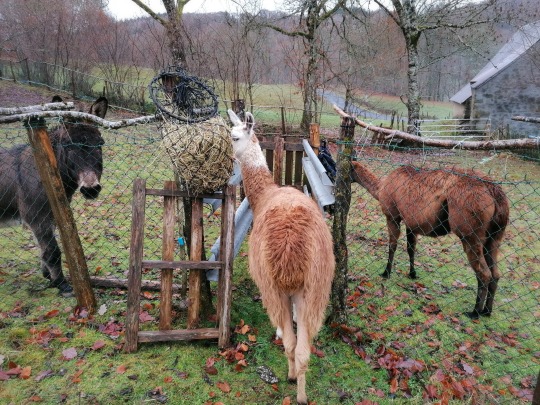
To congratulate her for remaining in the corral a couple more minutes than she strictly had to, she got an extra clementine peel that was meant for Pirlouit.

Still, she ran to her mum as soon as she was out of the corral and tried to nurse for comfort. The chute was a little bit scary. (And Pampe was like no, we’ve got hay right here, are you kidding me.)

Pampoldine took the rebuff philosophically. She didn’t look very traumatised by llama school, unlike Pampe who was extra annoying and elopey on days when she had to spend 5 min in the chute. Baby Poldine looked almost proud of herself !

Also unlike Pampe who sulked and avoided me for a while after every lesson, Poldine followed me when I went to give my last clementine peeling to Pirlouit, and tried to argue that she was more deserving of it.

And finally, when I looked back on my way home I saw that all the animals were outside the corral finishing the hay, except Poldine who had gone back inside all by herself and was curiously examining the chute she was stuck in 10 min before, like “what was that about”

So, a very positive first lesson! Poldine was such a good girl, and the drastic contrast with 2019 is another confirmation of what all of us already suspected (Pampe is Pampe.)
#crawling along#then again pampe becomes a model llama when she has an opportunity to gaslight me in front of strangers so it's okay#like when the shearer came and was like ''but what were you talking about this is the most cooperative llama in the world''#me: :l#(this post is dedicated to the anon who said poldine was their favourite along with pandolf because they're both sweethearts!#i'm happy to say she lived up to your expectations today)
1K notes
·
View notes
Text

Sears, 1970.
Models: Dayle Haddon and Terry Reno.
#i had no clue but dayle was modeling in the 60s alongside colleen corby & the like#dayle haddon#(L)#terry reno#(R)#1970#1970s
94 notes
·
View notes
Photo

Richard L. Shaefer - “How to Make Love Like a Witch” (Viva 1976)
#richard l. shaefer#viva magazine#photography#fashion photography#vintage fashion#vintage style#vintage#retro#aesthetic#beauty#seventies#70s#70s style#70s fashion#70s model#1970s#1970s fashion#editorial
2K notes
·
View notes
Text

#pretty#cute#hot#slim#fit#black and white#brunette#model#girls#denim#dungarees#anna ralphs#anna l#anastasiia mitina
96 notes
·
View notes
Text

What if Squip lightning
#art#be more chill#squip#bmc#bmc squip#squip fanart#be more chill fanart#listen i just think he'd find it intriguing#he's the only one who can canonically do it i think btw#pal gets some lightning but it's conditional#river gets nothing boohoo old model common L skill issue
109 notes
·
View notes
Text


10 mins later after majima convinced nishiki to go out on a guys night :)


10 YEARS IN THE JOINT
KIRYU WITH NISH EXPRESSION JUMPSCARE

#akira nishikiyama#kiryu kazuma#majima goro#yakuza#barbie#look at me taggin things for once#who knows if they'll show up lmao#im so sorry for kiwami nish smugass face asgdhajk#anyways WOT TOOK THE LONGEST WAS DECIDIN HOW TO POST THIS.#i couldnt decide if to put kiryu next to majima but i think thats already been done so lets go with this :)#but yea. NISH N MAJIMA ENDIN UP IN JAIL IS SO FUNNY TO ME#majima bein like ok lets do a lil bondin kid. ( also to apologize for kickin his ass that one time. )#nishiki being like sigh ok how ba-a-ad can it be#*10 minutes later* J A I L#THE SECOND ONE WITH KIRYU N NISH MAKES NO SENSE BUT I JUST THINK IS FUNNY ASDGHASD#also i need to say that the hands of yakuz models are wAY too big (not pictured here. i had to change some stuff)#ALSO MY FIRST TIME TRYIN TO POSE STUFF WITHOUT HELP FROM YAKUZZI ANIMATIONS#god these tags are gettin long. hello there
264 notes
·
View notes
Text






Ahri Project L Model & Textures - Blair Armitage
#ahri#league of legends#project l#league of legends champion#riot games#chroma skins#models#official
165 notes
·
View notes
Note
Is there an official design for Hello and Goodbye post-So(u)l?
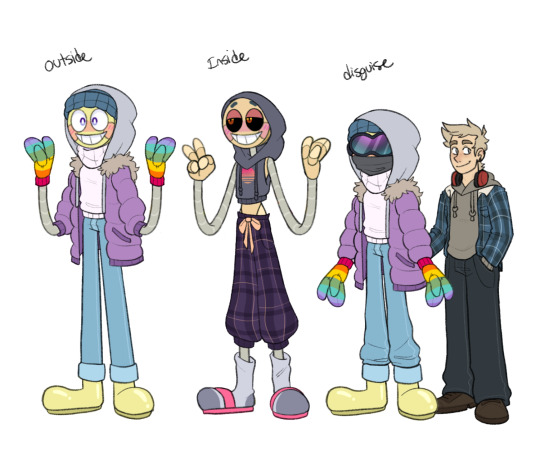
There is now! :D
#ask#so(u)l project#my art#hello n goodbye are modelling the diff outfits but they’re interchangeable#concept art
145 notes
·
View notes
Text

#afterdarkreblogs#hot nude#onlyf@nz#spicy pics#thick vibes only#l#memes#quotes#f#k#fotografia#beautiful#vintage#citazioni#followme#amore#style#aesthetics#explorepage#model#twitter#tumblrpost#meme#explore#music#pinterest#makeup#instalike#frasiamore#likeforfollow
77 notes
·
View notes
Text







1929 Lincoln Model L Seven-Passenger Touring,
Courtesy: Bonhams
#art#design#luxury cars#luxurycars#luxurylifestyle#vintage cars#vintage car#lincoln#1929#lincoln model L#touring#bonhams
98 notes
·
View notes